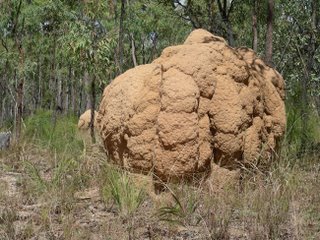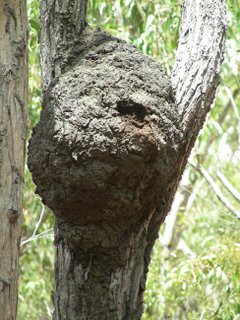Termites live just about everywhere there's vegetation but they are most conspicuous in the tropics, where several species build eye-catching mounds. The shape and location of these mounds vary with the species. Perhaps the most recognisable are the huge, knife-blade constructions of the magnetic termite (Amitermes spp.), which are orientated north – south.
 I didn't see any magnetic termites on this trip to Far North Queensland but I saw several other species. Two types of high-rise mounds are abundant along the road from Herberton to Irvinebank. Although they look different, they're both built by Nasutitermes termites. One species (I think it's N. triodiae) assembles massive mounds in open woodland. After rain, they plaster extensions onto the mound, holding the sandy soil in place with spit and poo. (They have more in common with the builder of my home than I anticipated.)
I didn't see any magnetic termites on this trip to Far North Queensland but I saw several other species. Two types of high-rise mounds are abundant along the road from Herberton to Irvinebank. Although they look different, they're both built by Nasutitermes termites. One species (I think it's N. triodiae) assembles massive mounds in open woodland. After rain, they plaster extensions onto the mound, holding the sandy soil in place with spit and poo. (They have more in common with the builder of my home than I anticipated.)  The other species (possibly N. walkeri) slaps its mound together high up in trees. This makes them popular with kingfishers, which excavate the mounds to create a nest.
The other species (possibly N. walkeri) slaps its mound together high up in trees. This makes them popular with kingfishers, which excavate the mounds to create a nest.Like ants (to which they are not closely related), termites are divided into castes. Each caste has a specialised role. But unlike those of other social insects, members of the soldier caste don't defend the mound with savage bites. Nasutitermes soldiers squirt glue at attackers through a nozzle on the head. The secretion sticks down small predators. It also contains volatile chemicals that repel larger attackers. Had I thought of it at the time, I would have annoyed them to find out the effectiveness of their defence.